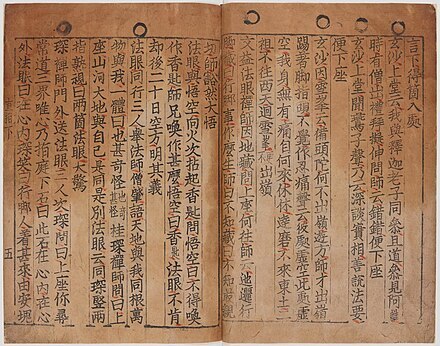Early Modern time period
Johannes Gutenberg, who is credited with bringing the movable type printing press to Europe in 1440, is frequently associated with modern book printing. Often referred to as the "Man of the Millennium," Gutenberg's creation transformed book production and increased accessibility and affordability. On the other hand, East Asia had established letterpress printing technology centuries earlier. Moving metal type was employed in Korea starting in the 1230s, which is a noteworthy development that came about more than two centuries before Gutenberg's printing press. The Jikji, a Buddhist literature whose full title is "Baegun hwasang chorok bulho jikji simche yojeol" (Anthology of Great Buddhist Priests’ Zen Teachings), is one of the most notable instances of early movable type printing. The Jikji is the oldest book still in existence to be printed using movable metal type. It was printed in Korea in 1377, under the Goryeo Dynasty. This demonstrates the sophisticated status of Korean printing technology much ahead of its European counterparts and predates the Gutenberg Bible, which is sometimes wrongly regarded as the oldest printed book.
The Buddhist monk Baegun and his students printed the Jikji at the Heungdeok-sa temple in Cheongju. The last volume of the original Jikji still exists and is kept in the National Library of France's (Bibliothèque nationale de France) Manuscripts Orientaux division, despite the remainder of the book having been lost. Victor Collin de Plancy brought this manuscript to France in the early 20th century, along with a number of other old Korean books. He later on decided to sell it to the BnF and they display the piece of work for one week annually because of how fragile it is. Throughout the Chinese Song dynasty (960–1279), the need for information for social and political advancement and the role of religion in encouraging literacy and text transmission were two of the main forces behind the creation and diffusion of printed books in East Asia. The Jikji, an assemblage of Zen teachings, mirrors this cultural context. Its use as a teaching tool for Zen Buddhism demonstrates the significant impact that academic and religious pursuits had on the advancement of printing technology.
The Jikji used techniques that were distinct from those subsequently employed by Gutenberg, even though they were printed using moveable type. The surviving copy's cover was recreated to maintain its original appearance, and the Korean text was written on extremely fine, white paper using traditional Indian ink. A single, incomplete copy of the Jikji printed in metal type still exists, but information from a woodblock print edition released a year after the metal type version has been added to the text. The historical relevance of the Jikji as a forerunner of early printing technology is highlighted by this preservation effort. The Jikji is a notable piece of work and its preservation underscores its pivotal role in the history of early printing technology, serving as a testament to its innovative techniques and cultural significance.

